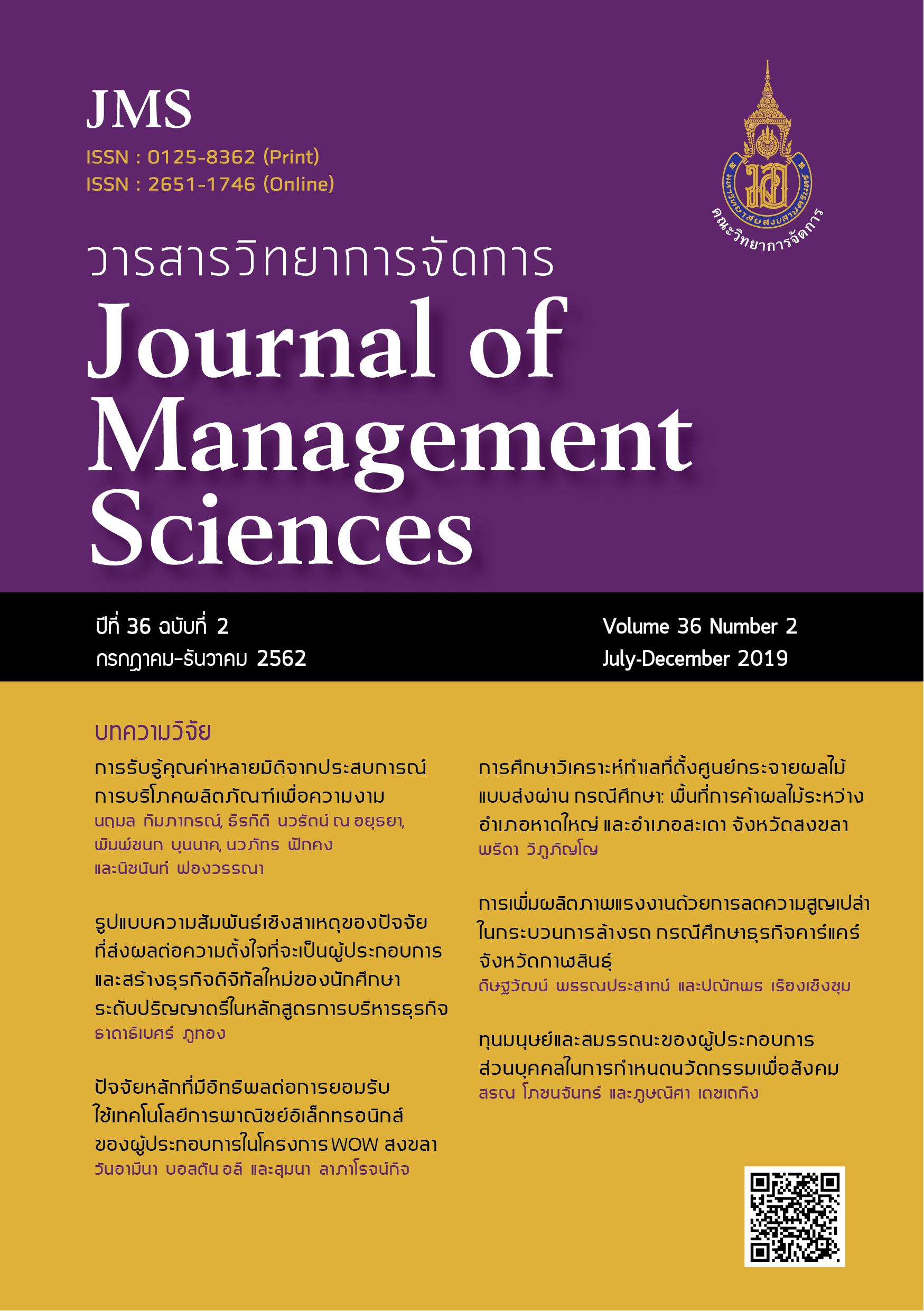Labor Productivity Improvement by Reducing Waste in Carwash Process: A Case Study of Carwash Business in Kalasin Province
Main Article Content
Abstract
Labor productivity improvement played a crucial role in increasing operational potential by suitably adjusting workers’ working patterns via waste reduction method. The purposes of this study were to evaluate labor productivity and to implement an approach to reduce waste in the carwash process. The data were collected from 16 key informants through participant observation and in-depth interview methods. The collected data were analyzed by several processes as follows: flow process chart, value-added activities, non-value-added activities but necessary and non-value-added activities, together with Why-Why Analysis, How-How Analysis, 5W1H and ECRS. The findings showed that, after the evaluation had been performed, the productivity scores of team A and B were at 1.85 and 1.96, respectively, car per labor hour. The researcher, thus, implemented an approach to increase labor productivity by reducing waste in the carwash process. It is found that the score of team A increased from 1.85 to 2.47 while that of team B from 1.96 to 2.50 car per labor hour. The operation time of team A was shortened from 32.43 to 24.30 and that of team B was from 31.07 to 24.00 minutes per car. By and Large, the researcher, thus, suggests entrepreneurs focus on increasing labor productivity by reducing waste as it might be useful for this carwash business.
Article Details

This work is licensed under a Creative Commons Attribution-NonCommercial-NoDerivatives 4.0 International License.
All published articles are SJMS’s copyright. The editorial board allows all published articles to be copied, excerpted, or disseminated with academic citation.
References
Caetano, A., Silva, A. R., and Tribolet, J. (2010). Business Process Decomposition-An Approach Based on the Principle of Separation of Concerns. Enterprise Modelling and Information Systems Architectures, 5(1), 44-57.
Detailing Trainer. (2018). Car Care is Carwash? Retrieved April 2, 2019, from https://www.detailingtrainer.com/content_dt006/
Djumin, S. C., Wibowo, Y., and Irani, S. A. (2001). Value Stream Mapping from an Industrial Engineering Viewpoint. Department of Industrial, Welding and Systems Engineering, The Ohio State University.
El-Namrouty, K. A., and AbuShaaban, M. S. (2013). Seven wastes elimination targeted by lean manufacturing case study “gaza strip manufacturing firms”. International Journal of Economics, Finance and Management Sciences, 1(2), 1-13.
Ghate, P. R., and Minde, P. (2016). Labour Productivity in Construction. Master of Engineering. Pune: Savitribai Phule Pune University.
Gopalakrishnan, T., and Saravanan, R. (2017). Cast Off expansion plan by rapid improvement through Optimization tool design, Tool Parameters and using Six Sigma’s ECRS Technique. IOP Conference Series: Materials Science and Engineering, 183(1), 12-16.
Hassan, M. F., and Jalaludin, I. M. (2016). Application of Why-Why Analysis to Improve Predictive Maintenance Strategy for Injection Molding Machine. Information Technology Journal, 15(4), 130-136.
Heizer, J., and Render, B. (2014). Operations Management: Sustainability and Supply and Supply Chain Management. 11th ed. New York: Pearson.
Heizer, J., Render, B., and Mundon, C. (2017). Principles of Operations Management: Sustainability and Supply and Supply Chain Management. 10th ed. New York: Pearson Education.
Kasikorn Research Center. (2014). The first car policy: the main car market stimulation in 2011 and 2012. Retrieved March 31, 2019, from https://kasikornresearch.com/th/analysis/k-econ/business/Pages/27471.aspx
Kavitha, S. S. (2017). A review on quantified impacts of construction labour productivity towards project performance. International Research Journal of Engineering and Technology (IRJET), 4(1), 1-4.
Khunthongjan, S. (2018). Increasing labor productivity of non-vocational graduates in happy-workplace organizations. Silpakorn University Journal, 38(4), 106-132.
Meedecha, D. (2017). An effect of people and human capital risk to labour productivity to in foreign direct investment in Thailand. Journal of Graduate Studies Valaya Alongkorn Rajabhat University, 11(2), 47-60.
National Statistical Office. (2017). Vehicles registered in Kalasin. Retrieved April5, 2016, from https://kalasin.nso.go.th/ index.php
Ohno, T. (2016). The Toyota Production System-The Key Elements and the Role of Kaizen within the System. Germany: Campus Verlag.
Soonthornchawakan, N. (2017). Occupational Productivity Differences of Thai Old Aged Labors. BU academic review, 15(1), 42-61.
Thai Franchise Center. (2014). Luxury Car Carwash Business is prosperous. Retrieved March 31, 2019, from https://www.thaifranchisecenter.com/info/show.php?etID=3071

